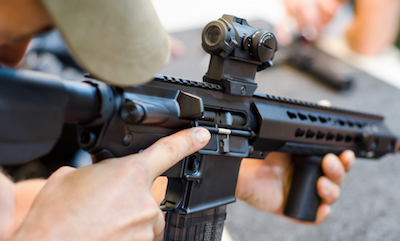States with Permissive Gun Laws Have Higher Mass Shooting Rates.
 States with more permissive gun laws and greater gun ownership have higher rates of mass shootings than states with more gun control and fewer guns, and the divide is growing, according to a new study co-authored by School of Public Health researchers.
States with more permissive gun laws and greater gun ownership have higher rates of mass shootings than states with more gun control and fewer guns, and the divide is growing, according to a new study co-authored by School of Public Health researchers.
The study, published in the British Medical Journal, found that each 10-unit increase in state permissiveness was associated with an 11 percent higher mass shooting rate, and a 10-percent-higher state firearm ownership rate was associated with a 35 percent higher rate of mass shootings.
“Permissive gun laws and increased gun ownership have had a big role in increasing the number of mass shootings that we experience in this nation,” says study co-author Bindu Kalesan, assistant professor of community health sciences. “Permissive gun laws have no place in civilized societies, and we need educational programs for reducing gun ownership.”
The researchers used the 1998 through 2015 editions of the Traveler’s Guide to the Firearms Laws of the Fifty States to create a restrictiveness–permissiveness scale of US state gun laws, including carry and permit requirements, semiautomatic guns and high capacity magazines, vehicle gun possession, carrying guns where alcohol is served, and out-of-state permit recognition, among others. Each state received a ranking for each year from 1998 to 2014, with a rating of zero (0) meaning the state’s gun laws were completely restrictive, and 100 meaning completely permissive.
The researchers then identified mass shootings (events in which four or more individuals were killed by a firearm) using the FBI’s Uniform Crime Reporting System in each state during those years. They also estimated gun ownership rates using a common state-level measure: the percent of suicides committed with a firearm.
They found an overall shift toward permissiveness in gun ownership between 1998 and 2014. Massachusetts had the most restrictive gun laws and Vermont had the most permissive over that period.
The researchers noted a growing divergence in 2010, with decreasing mass shooting rates among restrictive states and increasing rates among more permissive states. On average, more permissive states and states with higher rates of gun ownership had more mass shootings.
The researchers further separated annual mass shooting rates into events that likely took place in the home and outside of the home for each state, and found that both types of mass shootings were similarly affected by gun laws and gun ownership.
The study was also co-authored by Dean Sandro Galea. The study’s lead author was Paul Reeping of Columbia University Mailman School of Public Health; the other co-authors were Magdalena Cerda of New York University Langone School of Medicine, Douglas Wiebe of the Perelman School of Medicine at the University of Pennsylvania, and Charles Branas of Columbia Mailman School.